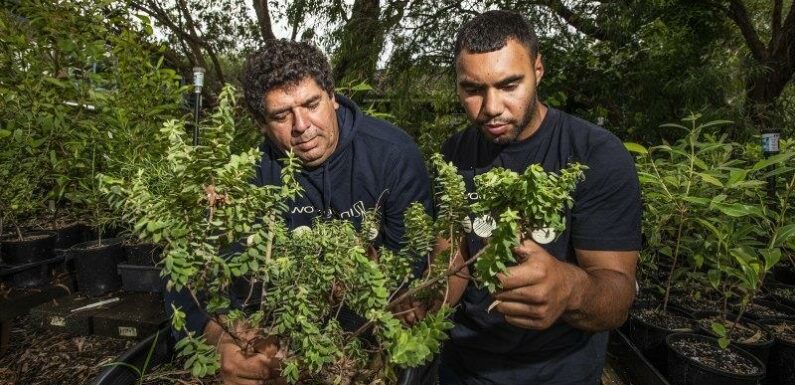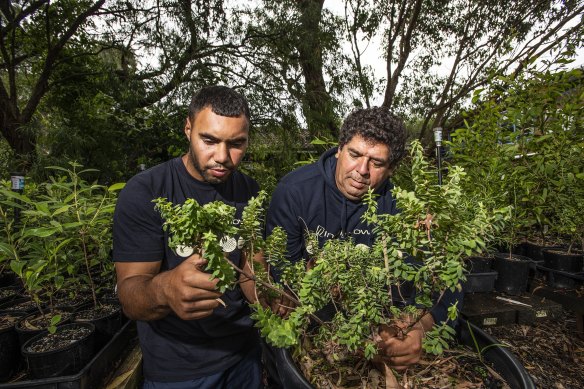
Eastern Suburbs Banksia Scrub may not sound exciting, but don’t be deceived, this plant community is one of Sydney’s treasures. Evolved to thrive in the nutrient-poor, sandy soils, hot sun and salty winds of the coast, it is a flower-filled, bio-diverse wonder of some 80 core species that once dominated an area of 5,300 hectares from North Head to Botany Bay.
In ESBS, as its called, banksias, wattles, tea-tree and shrubby casurinas give protection to shrubs like mountain devils, small-flowered grevilleas, and the nastily-named but very pretty cigarette flower, Epacris longiflora, so-called for its thin tubular white flowers with glowing red tips. Flannel flowers bloom in the sunny spots and grass trees add their distinctive form. Small mammals, birds and insects make ESBS home.
Peter Cooley, CEO of Indigrow, an Indigenous social enterprise and nursery that is trying to save one of Sydney’s critically endangered ecological treasures, the Eastern Suburbs Banksia Scrub. Peter is pictured with Tahi Williams-Forbes (left) with a rare Five Corners or Bush Lollies (Styphelia Viridis).Credit:Steven Siewert
Tragically only three per cent of this uniquely Sydney biosphere remains, wiped out by the triple threat of land clearing, feral plants and the end of the rejuvenating low temperature fires with which local people managed Country.
One nursery is on a mission to bring ESBS back from the brink of extinction. Indigigrow is a project of First Hand Solutions, which also runs Blak Markets and the National Indigenous Art Fair. Indigigrow CEO Peter Cooley says the project started with two key areas of focus – ESBS and bush foods.
The two come together in the story of one plant known as five corners. Botanically speaking five corners is Styphelia viridis, a stiff-leafed shrub less than a metre tall with tubular green flowers and five-pointed fruits renowned as one of the tastiest berries in the bush.
The reason we don’t all have one in the backyard gets back to one of the challenges in preserving ESBS – only a tiny proportion of its plants are commercially available.
Understandably, commercial nurseries prioritise plants that are easy to propagate, quick to grow and quick to sell. Five corners is anything but. Cooley says that despite years of trial and error Indigirow has still not germinated its seed.
“Some of our old people say that the fruit has to pass through the stomach of an animal before it can germinate,” he says, “and we do know it responds to fire.” While the seed remains persistently difficult, Indigigrow has had success with cuttings and has started to share the plant with local elders. “When all our old people can go into their backyards and share the five corners fruit with the young kids and tell them about culture, that will be our proudest moment,” says Cooley.
Indigigrow offers a wide range of ESBS plants and bush food plants from around the country at its two nurseries in La Perouse and Matraville. Why not try sea celery, Apium annuum, with a flavour a bit like parsley; a native raspberry such as Rubus parvifolius, which is a scrambling shrub about a metre high and wide that fruits well when grown in a pot; or if you have the room, a deliciously tart Davidson plum, Davidsonia jerseyana?
And if you live in the former heartlands of ESBS, Cooley says you can contribute to its preservation by planting what you can in the space you have. “Even if you have one plant in a pot on the balcony, the life dependent on that plant will find it. We have to care for it.”
Make the most of your health, relationships, fitness and nutrition with our Live Well newsletter. Get it in your inbox every Monday.
Most Viewed in Lifestyle
From our partners
Source: Read Full Article
